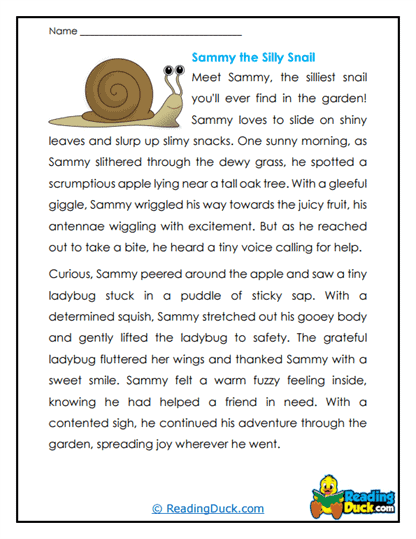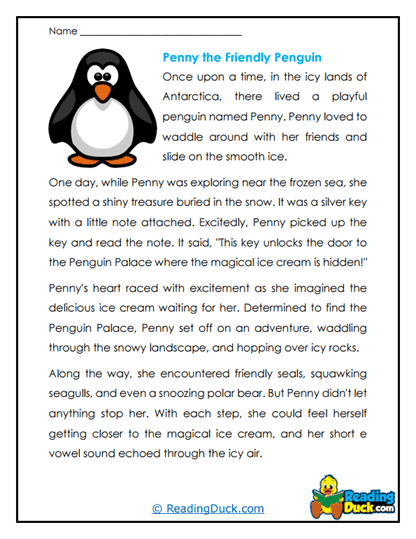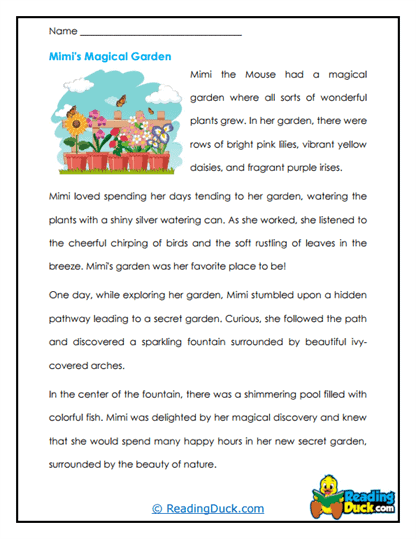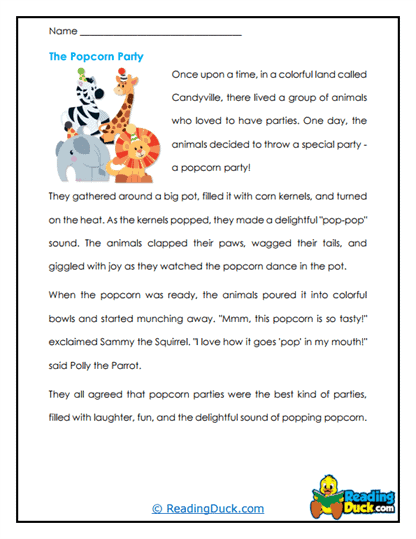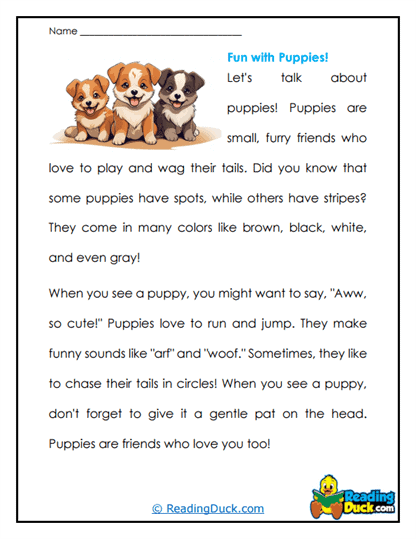Short Vowel Reading Passages Worksheets
About Our Short Vowel Reading Passages Worksheets
Our Short Vowel Reading Passages Worksheets are designed to help students develop essential phonics skills by focusing on the sounds of short vowels in words. Short vowels are foundational for early readers, and mastering them is crucial for both decoding and word recognition. These worksheets provide targeted reading passages that emphasize short vowel sounds, helping students strengthen their phonics skills and improve their reading fluency.
Each worksheet is provided in PDF format, making it simple to download, view, and print. The reading passages in this collection come with a set of multiple-choice questions to test students' comprehension and ensure they grasp the material. Additionally, each worksheet includes a downloadable answer key, providing educators, tutors, and parents with an easy reference for assessment and feedback.
The Importance of Short Vowel Mastery in Phonics
Short vowels are among the first sounds students learn when developing their reading skills. Mastering these sounds lays a solid foundation for reading success as students progress to more complex phonics patterns. The Short Vowel Reading Passages Worksheets help students become confident in recognizing, decoding, and using short vowel sounds across different contexts. These worksheets focus on the core short vowel sounds: /a/, /e/, /i/, /o/, and /u/.
- Builds Word Recognition: By engaging with short vowel-focused passages, students improve their ability to quickly recognize common words, helping them to read more fluently.
- Supports Decoding Skills: Students practice breaking down words and identifying short vowel sounds, which is essential for decoding new or unfamiliar words.
- Strengthens Reading Fluency: Regular exposure to short vowel words within reading passages helps students read more smoothly and with greater confidence.
- Improves Spelling Accuracy: Short vowels are common in many high-frequency words. Understanding these patterns improves spelling accuracy, making writing easier for students.
- Boosts Comprehension: The multiple-choice questions included with each passage ensure that students not only recognize short vowel sounds but also understand the content of the passage.
Best Practices for Using These Worksheets in the Classroom or at Home
These Short Vowel Reading Passages Worksheets can be easily integrated into various learning environments, whether in the classroom, at home, or as part of independent study routines. Below are practical strategies for using the worksheets to maximize learning and engagement:
- Daily Phonics Routine: Incorporate these worksheets into your daily phonics lessons. Have students read the passages aloud, paying close attention to identifying short vowel sounds.
- Independent Practice or Homework: These worksheets are ideal for assigning as independent practice or homework. Students can work on their own to reinforce the short vowel patterns they’ve learned in class.
- Small Group Reading Activities: Use the reading passages for small group work, where students can read together, discuss the short vowel words they encounter, and answer comprehension questions collaboratively.
- Assessment and Review: The multiple-choice questions make it easy to assess student comprehension. Use the downloadable answer keys to provide immediate feedback and track student progress over time.
- Phonics Intervention: For students who need extra support with short vowels, these worksheets can be used as part of a targeted intervention plan, offering additional opportunities to practice decoding and word recognition.
Supporting Literacy Development Through Short Vowel Practice
Short vowels play a vital role in early literacy development, as they appear frequently in simple words that students encounter in everyday reading. The Short Vowel Reading Passages Worksheets are designed to provide focused practice that strengthens multiple aspects of literacy:
- Improved Word Recognition: As students engage with passages that highlight short vowel sounds, they become more skilled at recognizing words automatically, which is key to reading fluency.
- Enhanced Decoding Abilities: By focusing on short vowel sounds in various contexts, students learn to decode words quickly, a skill that is essential for reading success.
- Fluency Development: Short vowel practice contributes to smoother and more fluid reading. Repeated exposure to short vowel patterns in different words helps students build reading speed and accuracy.
- Vocabulary Expansion: The passages introduce students to a variety of words that contain short vowels, helping them expand their vocabulary and become more familiar with high-frequency words.
- Comprehension Improvement: Each passage includes comprehension questions, ensuring that students are not only practicing phonics but also improving their understanding of the text.
Adapting the Worksheets for Different Learning Styles
Students have different learning styles, and these Short Vowel Reading Passages Worksheets can be adapted to meet the needs of diverse learners. Here are some tips for tailoring the worksheets to different learning preferences:
- For Visual Learners: Use visual aids, such as vowel charts or color-coded words, to help students see the relationship between the short vowel sounds and their corresponding letters.
- For Auditory Learners: Encourage students to read the passages aloud, focusing on the pronunciation of the short vowel sounds. Hearing the sounds as they read will reinforce their phonics skills.
- For Kinesthetic Learners: Have students trace or write short vowel words while reading the passages. This physical action can help reinforce the connection between the sound and the spelling of each word.
- For Struggling Readers: Break the passages into smaller, manageable sections and work through them with students who need extra support. Focus on one short vowel sound at a time, and provide additional practice before moving on to more complex words.
- For Advanced Learners: Challenge advanced students by asking them to find additional examples of short vowel words in other reading materials or create sentences using the short vowel words from the passages.
Building Reading Fluency Through Short Vowel Practice
Fluency is a key component of reading success, and regular practice with short vowels plays a significant role in developing fluent readers. These Short Vowel Reading Passages Worksheets provide students with the consistent, targeted practice they need to build fluency:
- Better Pronunciation: Short vowels can sometimes be tricky to pronounce correctly, especially in different word combinations. Regular practice with these passages helps students improve their pronunciation of short vowel sounds.
- Smoother Pacing: As students become more familiar with short vowel words, they begin to read at a more natural pace, which is crucial for fluent reading.
- Expression and Intonation: Fluent readers use expression and intonation when reading aloud. These passages offer opportunities for students to practice reading with expression while mastering short vowel sounds.
- Reading Confidence: The more practice students have with short vowel words, the more confident they become in their reading abilities. This confidence translates into a greater willingness to tackle more complex texts as their skills progress.
Encouraging Independent Reading Through Phonics Mastery
Helping students become independent readers is one of the primary goals of phonics instruction, and these Short Vowel Reading Passages Worksheets are an excellent tool for achieving that goal. By providing structured, consistent practice with short vowel sounds, these worksheets foster the phonics skills necessary for independent reading:
- Self-Paced Learning: The PDF format allows students to work through the passages at their own pace, giving them time to focus on mastering short vowel sounds without feeling rushed.
- Building Vocabulary Knowledge: As students encounter new words with short vowels in the passages, they expand their vocabulary, which helps them in both reading and writing.
- Long-Term Phonics Development: Mastery of short vowels is a fundamental step in phonics instruction. The skills learned through these passages provide the foundation for more advanced reading and literacy development.
Conclusion
The Short Vowel Reading Passages Worksheets offer an invaluable resource for educators, parents, and tutors who want to help students build essential phonics skills. By focusing on short vowel sounds in reading passages, these worksheets provide structured practice that enhances word recognition, decoding, and reading fluency. With easy-to-download PDF formats, comprehension-based multiple-choice questions, and answer keys for quick assessment, these worksheets can be seamlessly integrated into any learning routine. Whether used in the classroom, at home, or as part of independent study, these worksheets provide students with the tools they need to master short vowels and become more confident readers.
